A virtual bookshelf co-sponsored by the Council of Student Sustainability Leaders and Countway Library
The Council of Student Sustainability Leaders (CSSL), operating under the Harvard Office for Sustainability (OFS), is a group of Harvard undergraduate and graduate students who lead, organize, and participate in sustainability projects and groups throughout the university. The CSSL Bookshelf at Countway is a collection of thought-provoking sustainability books developed in collaboration with CSSL, Countway Library, and the Harvard Medical School community.
This collection amalgamates diverse perspectives into a curated and organized selection aimed at advancing and transferring knowledge for the betterment of the Harvard community and the planet.
Please suggest a book for the collection. To learn more about CSSL, please visit the CSSL website.
For questions, contact David Havelick, Office for Sustainability Associate Director
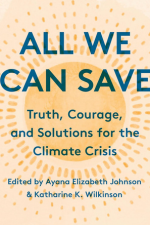 All We Can Save: Truth, Courage, and Solutions for the Climate Crisis
All We Can Save: Truth, Courage, and Solutions for the Climate Crisis
Edited by Ayana Elizabeth Johnson & Katharine K. Wilkinson
Recommended by: LMA campus students
Summary: All We Can Save illuminates the expertise and insights of dozens of diverse women leading on climate in the United States—scientists, journalists, farmers, lawyers, teachers, activists, innovators, wonks, and designers, across generations, geographies, and race—and aims to advance a more representative, nuanced, and solution-oriented public conversation on the climate crisis. These women offer a spectrum of ideas and insights for how we can rapidly, radically reshape society.
Keywords: Environmental Justice; Environmental Policy; Ecofeminism
Where to find it: All We Can Save is available via HOLLIS
 American War
American War
By Omar El Akkad
Recommended by: faculty/professors
Summary: A unique and eerily convincing masterwork, American War takes a scalpel to American politics, precisely dissecting it to see what would happen if their own policies were turned against them. The answer: inevitable, endless bloodshed.
Keywords: Fiction; Dystopia
Where to find it: American War is available via HOLLIS
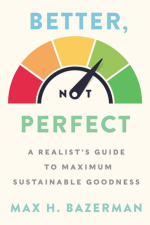 Better, Not Perfect: A Realist's Guide to Maximum Sustainable Goodness
Better, Not Perfect: A Realist's Guide to Maximum Sustainable Goodness
By Max H. Bazerman
Recommended by: CSSL
Summary: Better, Not Perfect provides a deeply researched, prescriptive roadmap for how to maximize our pleasure and minimize pain. Bazerman shares a framework to be smarter and more efficient, honest and aware—to attain your “maximum sustainable goodness.”
Keywords: Behavior; Business; Sustainability; Philosophy; Psychology
Where to find it: Better, Not Perfect is available via HOLLIS
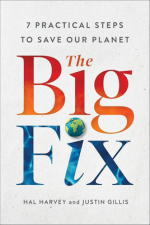 The Big Fix: 7 Practical Steps to Save Our Planet
The Big Fix: 7 Practical Steps to Save Our Planet
By Hal Harvey & Justin Gillis
Recommended by: CSSL
Summary: In The Big Fix, energy policy advisor Hal Harvey and longtime New York Times reporter Justin Gillis offer a new, hopeful way to engage with one of the greatest problems of our age. Writing in a lively, accessible style, the pair illuminate how the really big decisions that affect our climate get made—whether by the most obscure public utilities commissions or in the lofty halls of state capitols—and reveal how each of us can influence these decisions to deliver change. The pair focus on the seven areas of our political economy where ambitious but practical changes will have the greatest effect: from what kind of power plants to build to how much insulation new houses require to how efficient cars must be before they’re allowed on the road.
Keywords: Environmental Policy; Energy Policy; Activism, How-to
Where to find it: The Big Fix is available via HOLLIS
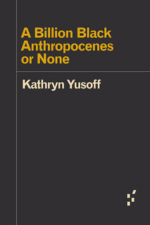 A Billion Black Anthropocenes or None
A Billion Black Anthropocenes or None
By Kathryn Yusoff
Recommended by: CSSL
Summary: Kathryn Yusoff examines how the grammar of geology is foundational to establishing the extractive economies of subjective life and the earth under colonialism and slavery. She initiates a transdisciplinary conversation between black feminist theory, geography, and the earth sciences, addressing the politics of the Anthropocene within the context of race, materiality, deep time, and the afterlives of geology.
Keywords: Geology; Ethnicity; Climate Change; Climate Justice
Where to find it: A Billion Black Anthropocenes or None is available via HOLLIS
 A Children's Bible: A Novel
A Children's Bible: A Novel
By Lydia Millet
Recommended by: faculty/professors
Summary: A Children’s Bible follows a group of twelve eerily mature children on a forced vacation with their families at a sprawling lakeside mansion. Contemptuous of their parents, the children decide to run away when a destructive storm descends on the summer estate, embarking on a dangerous foray into the apocalyptic chaos outside. Lydia Millet’s prophetic and heartbreaking story of generational divide offers a haunting vision of what awaits us on the far side of Revelation.
Keywords: Fiction; Environmental Disasters; Family Vacation
Where to find it: A Children's Bible is available via HOLLIS
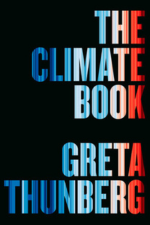 The Climate Book
The Climate Book
By Greta Thunberg
Recommended by: CSSL
Summary: In The Climate Book, Greta Thunberg has gathered the wisdom of over one hundred experts—geophysicists, oceanographers and meteorologists; engineers, economists and mathematicians; historians, philosophers and Indigenous leaders—to equip us all with the knowledge we need to combat climate disaster. Alongside them, she shares her own stories of demonstrating and uncovering greenwashing around the world, revealing how much we have been kept in the dark. This is one of our biggest challenges, she shows, but also our greatest source of hope. Once we are given the full picture, how can we not act? And if a schoolchild’s strike could ignite a global protest, what could we do collectively if we tried?
Keywords: Civil Liberties; Political Activism
Where to find it: The Climate Book is available via HOLLIS
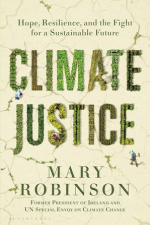 Climate Justice: Hope, Resilience, and the Fight for a Sustainable Future
Climate Justice: Hope, Resilience, and the Fight for a Sustainable Future
By Mary Robinson
Recommended by: faculty/professors
Summary: Former President of Ireland Mary Robinson's mission to bring together the fight against climate change and the global struggle for human rights has taken her all over the world. It also brought her to a heartening revelation: that that an irrepressible driving force in the battle for climate justice could be found at the grassroots level, mainly among women, many of them mothers and grandmothers like herself. Robinson met with ordinary people whose resilience and ingenuity had already unlocked extraordinary change: from a Mississippi matriarch whose campaign began in her East Biloxi hair salon and culminated in her speaking at the United Nations, to a farmer who transformed the fortunes of her ailing community in rural Uganda. In Climate Justice, she shares their stories, and many more. Powerful and deeply humane, this uplifting book is a stirring manifesto on one of the most pressing humanitarian issues of our time, and a lucid, affirmative, and well-argued case for hope.
Keywords: Environmental Justice; Environmental Policy; Activism; Social Justice
Where to find it: Climate Justice is available via HOLLIS
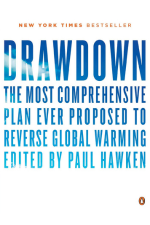 Drawdown: The Most Comprehensive Plan Ever Proposed to Reverse Global Warming
Drawdown: The Most Comprehensive Plan Ever Proposed to Reverse Global Warming
Edited by Paul Hawken
Recommended by: CSSL
Summary: In the face of widespread fear and apathy, an international coalition of researchers, professionals, and scientists have come together to offer a set of realistic and bold solutions to climate change. One hundred techniques and practices are described here—some are well known; some you may have never heard of. They range from clean energy to educating girls in lower-income countries to land use practices that pull carbon out of the air. The solutions exist, are economically viable, and communities throughout the world are currently enacting them with skill and determination. If deployed collectively on a global scale over the next thirty years, they represent a credible path forward, not just to slow the earth’s warming but to reach drawdown, that point in time when greenhouse gases in the atmosphere peak and begin to decline. These measures promise cascading benefits to human health, security, prosperity, and well-being—giving us every reason to see this planetary crisis as an opportunity to create a just and livable world.
Keywords: Environmental Policy; Sustainable Living; Sustainable Development
Where to find it: Drawdown is available via HOLLIS
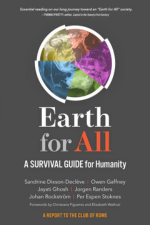 Earth for All: A Survival Guide for Humanity
Earth for All: A Survival Guide for Humanity
By Sandrine Dixson-Declève, Owen Gaffney, Jayati Ghosh, Jorgen Randers, Johan Rockström, and Per Espen Stoknes with Forewords by Christiana Figueres and Elizabeth Wathuti
Recommended by: CSSL
Summary: Earth For All is an antidote to despair. Combining the global economy, population, inequality, food, and energy in a state-of-the art computer model, a leading group of scientists and economists present a plan of five system-shifting steps to achieve prosperity for all within planetary limits in a single generation.
Keywords: Business; Economics; Development; Sustainable Development
Where to find it: Earth for All is available via HOLLIS
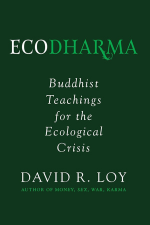 Ecodharma: Buddhist Teachings for the Ecological Crisis
Ecodharma: Buddhist Teachings for the Ecological Crisis
By David R. Loy
Recommended by: CSSL
Summary: This landmark work is simultaneously a manifesto, a blueprint, a call to action, and a deep comfort for troubling times. David R. Loy masterfully lays out the principles and perspectives of Ecodharma—the Buddhist response to our ecological predicament, a new term for a new development of the Buddhist tradition.
Keywords: Buddhism; Spirituality; Mindfulness
Where to find it: Ecodharma is available via HOLLIS
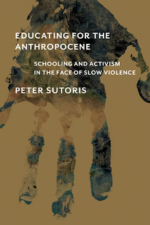 Educating for the Anthropocene: Schooling and Activism in the Face of Slow Violence
Educating for the Anthropocene: Schooling and Activism in the Face of Slow Violence
By Peter Sutoris
Recommended by: CSSL
Summary: Education has never played as critical a role in determining humanity's future as it does in the Anthropocene, an era marked by humankind's unprecedented control over the natural environment. Drawing on a multisited ethnographic project among schools and activist groups in India and South Africa, Peter Sutoris explores education practices in the context of impoverished, marginal communities where environmental crises intersect with colonial and racist histories and unsustainable practices. He exposes the depoliticizing effects of schooling and examines cross-generational knowledge transfer within and beyond formal education. Finally, he calls for the bridging of schooling and environmental activism, to find answers to the global environmental crisis.
Keywords: Education; Environmental Education; Environmental Activism
Where to find it: Educating for the Anthropocene is available via HOLLIS
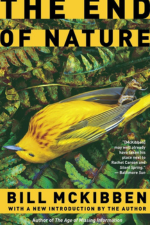 The End of Nature
The End of Nature
By Bill McKibben
Recommended by: LMA campus students
Summary: This impassioned plea for radical and life-renewing change is today still considered a groundbreaking work in environmental studies. McKibben’s argument that the survival of the globe is dependent on a fundamental, philosophical shift in the way we relate to nature is more relevant than ever. McKibben writes of our earth’s environmental cataclysm, addressing such core issues as the greenhouse effect, acid rain, and the depletion of the ozone layer. His new introduction addresses some of the latest environmental issues that have risen during the 1990s. The book also includes an invaluable new appendix of facts and figures that surveys the progress of the environmental movement.
Keywords: Environmental Conservation & Protection; Global Warming
Where to find it: The End of Nature is available via HOLLIS
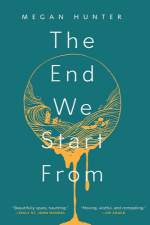 The End We Start From
The End We Start From
By Megan Hunter
Recommended by: faculty/professors
Summary: A startlingly beautiful story of a family’s survival, The End We Start From is a searing original, a modern-day parable of rebirth and renewal, of maternal bonds, and the instinct to survive and thrive in the absence of all that’s familiar.
As London is submerged below floodwaters, a woman gives birth to her first child, Z. Days later, she and her baby are forced to leave their home in search of safety. They head north through a newly dangerous country seeking refuge from place to place. Their journey traces fear and wonder as the baby grows, thriving and content against all the odds.
The End We Start From is an indelible and elemental first book—a lyrical vision of the strangeness and beauty of new motherhood, and a tale of endurance in the face of ungovernable change.
Keywords: Fiction; Motherhood
Where to find it: The End We Start From is available via HOLLIS
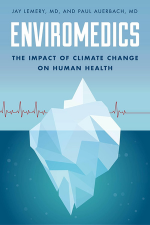 Enviromedics: The Impact of Climate Change on Human Health
Enviromedics: The Impact of Climate Change on Human Health
By Jay Lemery, MD & Paul Auerbach, MD
Recommended by: LMA campus students
Summary: Many of us have concerns about the effects of climate change on Earth, but we often overlook the essential issue of human health. This book addresses that oversight and enlightens readers about the most important aspect of one of the greatest challenges of our time.
By weighing in from a physician’s perspective, Jay Lemery and Paul Auerbach clarify the science, dispel the myths, and help readers understand the threats of climate change to human health. No better argument exists for persuading people to care about climate change than a close look at its impacts on our physical and emotional well-being.
Keywords: Human Health; Medicine; Science
Where to find it: Enviromedics is available via HOLLIS
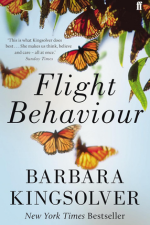 Flight Behavior
Flight Behavior
By Barbara Kingsolver
Recommended by: faculty/professors
Summary: Flight Behavior is a brilliant and suspenseful novel set in present day Appalachia; a breathtaking parable of catastrophe and denial that explores how the complexities we inevitably encounter in life lead us to believe in our particular chosen truths. Kingsolver's riveting story concerns a young wife and mother on a failing farm in rural Tennessee who experiences something she cannot explain, and how her discovery energizes various competing factions—religious leaders, climate scientists, environmentalists, politicians—trapping her in the center of the conflict and ultimately opening up her world. Flight Behavior represents contemporary American fiction at its finest.
Keywords: Fiction; Thriller
Where to find it: Flight Behavior is available via HOLLIS
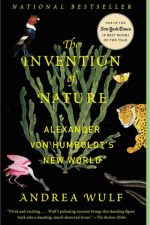 The Invention of Nature: Alexander von Humboldt's New World
The Invention of Nature: Alexander von Humboldt's New World
By Andrea Wulf
Recommended by: CSSL
Summary: In this illuminating biography, Andrea Wulf brings Humboldt’s extraordinary life back into focus: his prediction of human-induced climate change; his daring expeditions to the highest peaks of South America and to the anthrax-infected steppes of Siberia; his relationships with iconic figures, including Simón Bolívar and Thomas Jefferson; and the lasting influence of his writings on Darwin, Wordsworth, Goethe, Muir, Thoreau, and many others. Brilliantly researched and stunningly written, The Invention of Nature reveals the myriad ways in which Humboldt’s ideas form the foundation of modern environmentalism—and reminds us why they are as prescient and vital as ever.
Keywords: Nature; History; Biography (Humboldt); Memoir; Conservation; South America; Europe
Where to find it: The Invention of Nature is available via HOLLIS
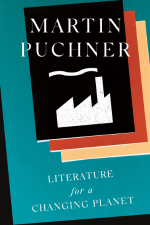 Literature for a Changing Planet
Literature for a Changing Planet
By Martin Puchner
Recommended by: CSSL
Summary: In Literature for a Changing Planet, Martin Puchner ranges across four thousand years of world literature to draw vital lessons about how we put ourselves on the path of climate change—and how we might change paths before it’s too late.
Keywords: Humanities; Climate Change Narratives
Where to find it: Literature for a Changing Planet is available via HOLLIS
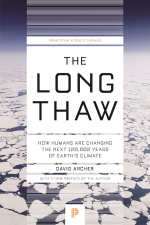 The Long Thaw: How Humans Are Changing the Next 100,000 Years of Earth's Climate
The Long Thaw: How Humans Are Changing the Next 100,000 Years of Earth's Climate
By David Archer
Recommended by: CSSL
Summary: The human impact on Earth’s climate is often treated as a hundred-year issue lasting as far into the future as 2100, the year in which most climate projections cease. In The Long Thaw, David Archer, one of the world’s leading climatologists, reveals the hard truth that these changes in climate will be “locked in,” essentially forever.
Keywords: Paleoclimatology; Geology
Where to find it: The Long Thaw is available via HOLLIS
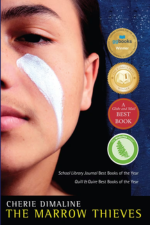 The Marrow Thieves
The Marrow Thieves
By Cherie Dimaline
Recommended by: faculty/professors
Summary: Humanity has nearly destroyed its world through global warming, but now an even greater evil lurks. The indigenous people of North America are being hunted and harvested for their bone marrow, which carries the key to recovering something the rest of the population has lost: the ability to dream. In this dark world, Frenchie and his companions struggle to survive as they make their way up north to the old lands. For now, survival means staying hidden—but what they don't know is that one of them holds the secret to defeating the marrow thieves.
Keywords: Fiction; Dystopia, Science Fiction
Where to find it: The Marrow Thieves is available via HOLLIS
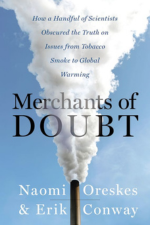 Merchants of Doubt: How a Handful of Scientists Obscured the Truth on Issues from Tobacco Smoke to Global Warming
Merchants of Doubt: How a Handful of Scientists Obscured the Truth on Issues from Tobacco Smoke to Global Warming
By Naomi Oreskes & Erik M. Conway
Recommended by: CSSL
Summary: Merchants of Doubt tells the disquieting story of how a loose-knit group of high-level scientists and scientific advisers, with deep connections in politics and industry, ran effective campaigns to mislead the public and deny well-established scientific knowledge over four decades. The same individuals who claim the science of global warming is “not settled” have also denied the truth about studies linking smoking to lung cancer, coal smoke to acid rain, and CFCs to the ozone hole. “Doubt is our product,” wrote one tobacco executive. These “experts” supplied it. Merchants of Doubt rolls back the rug on this dark corner of American science. Now with a new Foreword by former Vice President Al Gore, and with a new Postscript by the authors.
Keywords: Role of Science in Society; Politics of Science; History of Science
Where to find it: Merchants of Doubt is available via HOLLIS
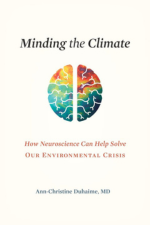 Minding the Climate: How Neuroscience Can Help Solve Our Environmental Crisis
Minding the Climate: How Neuroscience Can Help Solve Our Environmental Crisis
By Ann-Christine Duhaime, MD
Recommended by: CSSL
Summary: A neurosurgeon explores how our tendency to prioritize short-term consumer pleasures spurs climate change, but also how the brain’s amazing capacity for flexibility can—and likely will—enable us to prioritize the long-term survival of humanity.
Keywords: Neuroscience; Cognitive Science; Climate Change
Where to find it: Minding the Climate is available via HOLLIS
 The Ministry for the Future: A Novel
The Ministry for the Future: A Novel
By Kim Stanley Robinson
Recommended by: CSSL/LMA campus students
Summary: The Ministry for the Future is a masterpiece of the imagination, using fictional eyewitness accounts to tell the story of how climate change will affect us all. Its setting is not a desolate, post-apocalyptic world, but a future that is almost upon us. Chosen by Barack Obama as one of his favorite books of the year, this extraordinary novel from visionary science fiction writer Kim Stanley Robinson will change the way you think about the climate crisis.
Keywords: Climate Change
Where to find it: The Ministry for the Future is available via HOLLIS
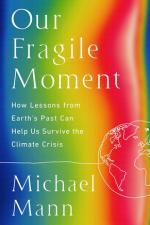 Our Fragile Moment: How Lessons from Earth's Past Can Help Us Survive the Climate Crisis
Our Fragile Moment: How Lessons from Earth's Past Can Help Us Survive the Climate Crisis
By Michael Mann
Recommended by: CSSL
Summary: In this sweeping work of science and history, the renowned climate scientist and author of The New Climate War shows us the conditions on Earth that allowed humans not only to exist but thrive, and how they are imperiled if we veer off course. In this book, renowned climate scientist Michael Mann will arm readers with the knowledge necessary to appreciate the gravity of the unfolding climate crisis, while emboldening them—and others—to act before it truly does become too late.
Keywords: Historical; Non-fiction
Where to find it: Our Fragile Moment is available via HOLLIS
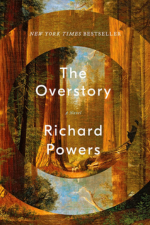 The Overstory
The Overstory
By Richard Powers
Recommended by: CSSL/LMA campus students
Summary: The Overstory, winner of the 2019 Pulitzer Prize in Fiction, is a sweeping, impassioned work of activism and resistance that is also a stunning evocation of—and paean to—the natural world. From the roots to the crown and back to the seeds, Richard Powers’s twelfth novel unfolds in concentric rings of interlocking fables that range from antebellum New York to the late twentieth-century Timber Wars of the Pacific Northwest and beyond. There is a world alongside ours—vast, slow, interconnected, resourceful, magnificently inventive, and almost invisible to us. This is the story of a handful of people who learn how to see that world and who are drawn up into its unfolding catastrophe.
Keywords: Nature; Sustainability; Storytelling; Activism; Fiction
Where to find it: The Overstory is available via HOLLIS
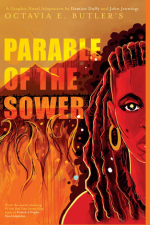 The Parable of the Sower
The Parable of the Sower
By Octavia E. Butler
Recommended by: faculty/professor
Summary: When global climate change and economic crises lead to social chaos in the early 2020s, California becomes full of dangers, from pervasive water shortage to masses of vagabonds who will do anything to live to see another day. Fifteen-year-old Lauren Olamina lives inside a gated community with her preacher father, family, and neighbors, sheltered from the surrounding anarchy. In a society where any vulnerability is a risk, she suffers from hyper-empathy, a debilitating sensitivity to others' emotions.
Precocious and clear-eyed, Lauren must make her voice heard in order to protect her loved ones from the imminent disasters her small community stubbornly ignores. But what begins as a fight for survival soon leads to something much more: the birth of a new faith . . . and a startling vision of human destiny.
Keywords: Novel; Graphic Novel; Dystopian
Where to find it: The Parable of the Sower is available via HOLLIS
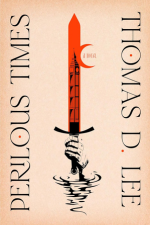 Perilous Times
Perilous Times
By Thomas D. Lee
Recommended by: faculty/professor
Summary: An immortal Knight of the Round Table faces his greatest challenge yet—saving the politically polarized, rapidly warming world from itself—in this slyly funny contemporary take on Arthurian legend.
Keywords: Fantasy; Fiction
Where to find it: Perilous Times is available via HOLLIS
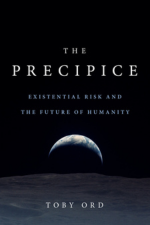 The Precipice: Existential Risk and the Future of Humanity
The Precipice: Existential Risk and the Future of Humanity
By Toby Ord
Recommended by: CSSL
Summary: Drawing on over a decade of research, The Precipice explores the cutting-edge science behind the risks we face. It puts them in the context of the greater story of humanity: showing how ending these risks is among the most pressing moral issues of our time. And it points the way forward, to the actions and strategies that can safeguard humanity.
Keywords: Philosophy; Sociology
Where to find it: The Precipice is available via HOLLIS
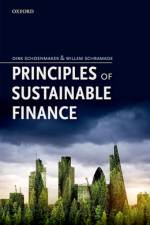 Principles of Sustainable Finance
Principles of Sustainable Finance
By Dirk Schoenmaker & Willem Schramade
Recommended by: CSSL
Summary: Principles of Sustainable Finance explains how the financial sector can be mobilized to counter this. Using finance as a means to achieve social goals, we can divert the planet and its economy from its current path to a world that is sustainable for all.
Keywords: Social Sciences; Economics; Sustainability; Finance
Where to find it: Principles of Sustainable Finance is available via HOLLIS
 Regenesis: Feeding the World Without Devouring the Planet
Regenesis: Feeding the World Without Devouring the Planet
By George Monbiot
Recommended by: CSSL
Summary: Regenesis is a breathtaking vision of a new future for food and for humanity. Drawing on astonishing advances in soil ecology, Monbiot reveals how our changing understanding of the world beneath our feet could allow us to grow more food with less farming. He meets the people who are unlocking these methods, from the fruit and vegetable grower revolutionizing our understanding of fertility; through breeders of perennial grains, liberating the land from plows and poisons; to the scientists pioneering new ways to grow protein and fat. Together, they show how the tiniest life forms could help us make peace with the planet, restore its living systems, and replace the age of extinction with an age of regenesis.
Keywords: Non-fiction; Agriculture; Science
Where to find it: Regenesis is available via HOLLIS
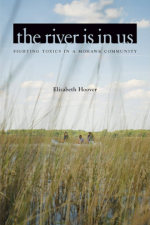 The River Is In Us: Fighting Toxics in a Mohawk Community
The River Is In Us: Fighting Toxics in a Mohawk Community
By Elizabeth Hoover
Recommended by: LMA campus students
Summary: In The River Is in Us, author Elizabeth Hoover takes us deep into this remarkable community that has partnered with scientists and developed grassroots programs to fight the contamination of its lands and reclaim its health and culture. Through in-depth research into archives, newspapers, and public meetings, as well as numerous interviews with community members and scientists, Hoover shows the exact efforts taken by Akwesasne's massive research project and the grassroots efforts to preserve the Native culture and lands. She also documents how contaminants have altered tribal life, including changes to the Mohawk fishing culture and the rise of diabetes in Akwesasne.
Keywords: Environmental Policy; Environmental Health; Health and Hygiene; Native American Studies
Where to find it: The River Is In Us is available via HOLLIS
 Scarcity: A History from the Origins of Capitalism to the Climate Crisis
Scarcity: A History from the Origins of Capitalism to the Climate Crisis
By Fredrik Albritton Jonsson & Carl Wennerlind
Recommended by: CSSL
Summary: A sweeping intellectual history of the concept of economic scarcity—its development across five hundred years of European thought and its decisive role in fostering the climate crisis.
Keywords: Business; Economic History; Capitalism; Political Economy; History; Climate Change
Where to find it: Scarcity is available via HOLLIS
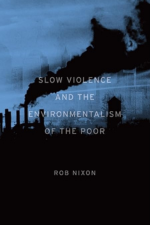 Slow Violence and the Environmentalism of the Poor
Slow Violence and the Environmentalism of the Poor
By Richard Nixon
Recommended by: LMA campus students
Summary: In a book of extraordinary scope, Nixon examines a cluster of writer-activists affiliated with the environmentalism of the poor in the global South. By approaching environmental justice literature from this transnational perspective, he exposes the limitations of the national and local frames that dominate environmental writing. And by skillfully illuminating the strategies these writer-activists deploy to give dramatic visibility to environmental emergencies, Nixon invites his readers to engage with some of the most pressing challenges of our time.
Keywords: Activism; Non-fiction; Environmental Justice
Where to find it: Slow Violence and the Environmentalism of the Poor is available via HOLLIS
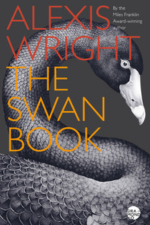 The Swan Book
The Swan Book
By Alexis Wright
Recommended by: faculty/professors
Summary: The Swan Book is set in the future, with Aboriginal peoples still living under the Intervention in the north, in an environment fundamentally altered by climate change. It follows the life of a mute young woman called Oblivia, the victim of gang-rape by petrol-sniffing youths, from the displaced community where she lives in a hulk, in a swamp filled with rusting boats, and thousands of black swans, to her marriage to Warren Finch, the first Aboriginal president of Australia, and her elevation to the position of First Lady, confined to a tower in a flooded and lawless southern city.
Keywords: Fiction; Dystopian; Indigenous Studies
Where to find it: The Swan Book is available via HOLLIS
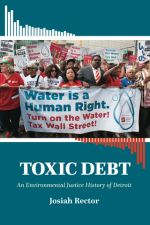 Toxic Debt: An Environmental Justice History of Detroit
Toxic Debt: An Environmental Justice History of Detroit
By Josiah Rector
Recommended by: CSSL
Summary: Toxic Debt is not only a book about racism, capitalism, and the making of these environmental disasters. It is also a history of Detroit's environmental justice movement, which emerged from over a century of battles over public health in the city and involved radical auto workers, ecofeminists, and working-class women fighting for clean water. Linking the histories of urban political economy, the environment, and social movements, Toxic Debt lucidly narrates the story of debt, environmental disaster, and resistance in Detroit.
Keywords: Environmental Studies; Political History; Public Policy; Social Issues; African American Studies
Where to find it: Toxic Debt is available via HOLLIS
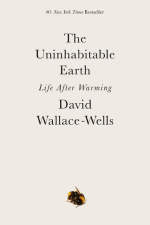 The Uninhabitable Earth: Life After Warming
The Uninhabitable Earth: Life After Warming
By David Wallace-Wells
Recommended by: CSSL
Summary: The Uninhabitable Earth is both a travelogue of the near future and a meditation on how that future will look to those living through it—the ways that warming promises to transform global politics, the meaning of technology and nature in the modern world, the sustainability of capitalism and the trajectory of human progress.
The Uninhabitable Earth is also an impassioned call to action. For just as the world was brought to the brink of catastrophe within the span of a lifetime, the responsibility to avoid it now belongs to a single generation—today’s.
Keywords: Science; Domestic Politics
Where to find it: The Uninhabitable Earth is available via HOLLIS
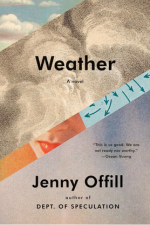 Weather
Weather
By Jenny Offill
Recommended by: faculty/professors
Summary: Lizzie works in the library of a university where she was once a promising graduate student. Her side hustle is answering the letters that come in to Hell and High Water, the doom-laden podcast hosted by her former mentor. At first it suits her, this chance to practice her other calling as an unofficial shrink—she has always played this role to her divorced mother and brother recovering from addiction—but soon Lizzie finds herself struggling to strike the obligatory note of hope in her responses. The reassuring rhythms of her life as a wife and mother begin to falter as her obsession with disaster psychology and people preparing for the end of the world grows. A marvelous feat of compression, a mix of great feeling and wry humor, Weather is an electrifying encounter with one of the most gifted writers at work today.
Keywords: Fiction; Psychology
Where to find it: Weather is available via HOLLIS
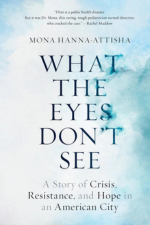 What the Eyes Don't See: A Story of Crisis, Resistance, and Hope in an American City
What the Eyes Don't See: A Story of Crisis, Resistance, and Hope in an American City
By Mona Hanna-Attisha
Recommended by: CSSL
Summary: What the Eyes Don’t See is a riveting account of a shameful disaster that became a tale of hope, the story of a city on the ropes that came together to fight for justice, self-determination, and the right to build a better world for their—and all of our—children.
Keywords: Environmental Justice; Health Equity; Public Health
Where to find it: What the Eyes Don't See is available via HOLLIS
 World Without End: An Illustrated Guide to the Climate Crisis
World Without End: An Illustrated Guide to the Climate Crisis
By Jean-Marc Jancovici & Christophe Blain
Recommended by: LMA campus students
Summary: In this intelligent, eye-opening, and witty international bestseller, an eminent climate expert takes a graphic novelist on a journey to understand the profound changes that our planet is experiencing. The scientist, Jean-Marc Jancovici, explains the workings of superpowers and history; oil and climate; ecology, economics, and energy flows. He describes, in short, the world we live in today—a world whose future is deeply uncertain. The artist, Christophe Blain, intently listens and draws.
Keywords: Graphic Novel
Where to find it: World Without End is available via the Boston Public Library
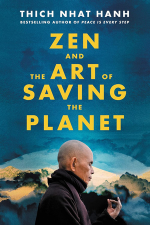 Zen and the Art of Saving the Planet
Zen and the Art of Saving the Planet
By Thich Nhat Hanh
Recommended by: CSSL
Summary: Mindfulness and the radical insights of Zen meditation can give us the strength and clarity we need to help create a regenerative world in which all life is respected. Filled with Thich Nhat Hanh’s inspiring meditations, Zen stories and experiences from his own activism, as well as commentary from Sister True Dedication, one of his students, Zen and the Art of Saving the Planet shows us a new way of seeing and living that can bring healing and harmony to ourselves, our relationships, and the Earth.
Keywords: Buddhism; Spirituality; Mindfulness
Where to find it: Zen and the Art of Saving the Planet is available via HOLLIS
